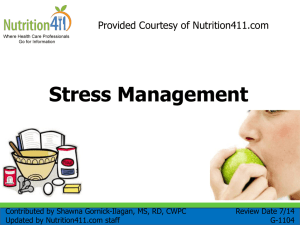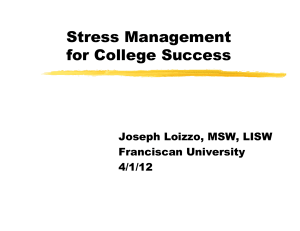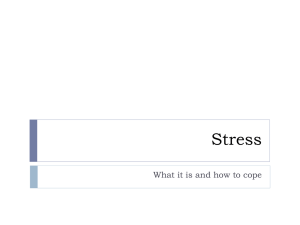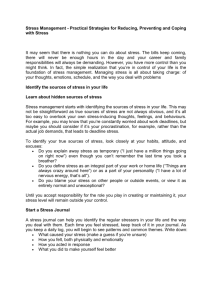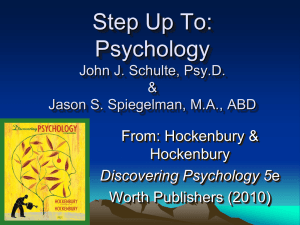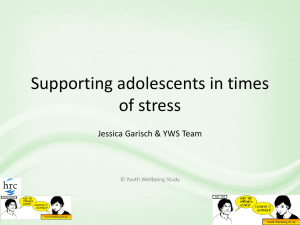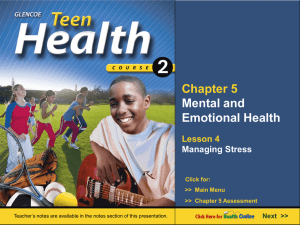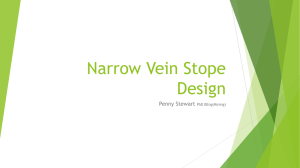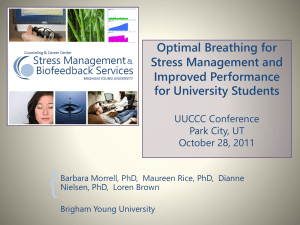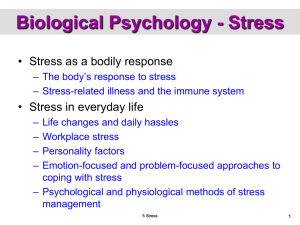Taking Care of Ourselves: Stress Reduction Workshop
advertisement
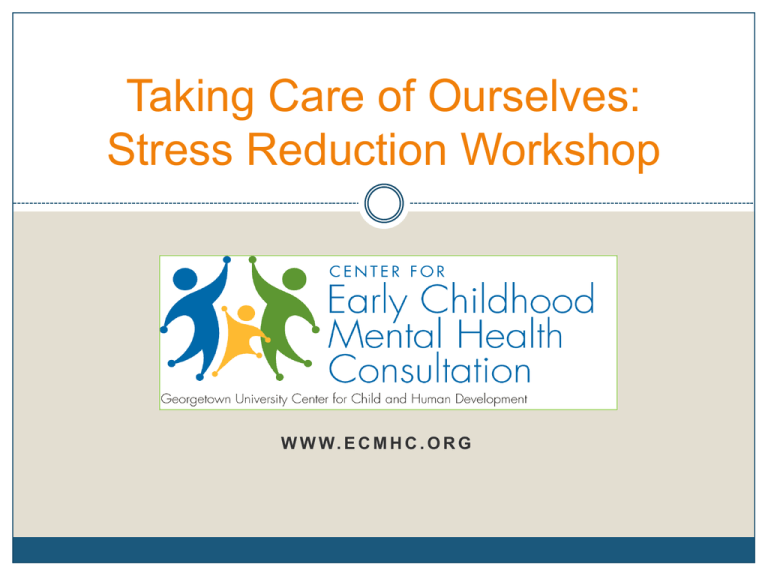
Taking Care of Ourselves: Stress Reduction Workshop W W W. E C M H C . O R G Acknowledgements This presentation was developed for the Center for Early Childhood Mental Health Consultation, an Innovation and Improvement Project funded by the Office o f H e a d S t a r t / A C F, D H H S Grant #90YD0268 “ Ta k i n g C a r e o f O u r s e l v e s ” Introduction and Rationale Providing care to young children is an intense and demanding job. Parents and teachers are under pressure to meet the demands of running a household/classroom, personal concerns, and responding to the child/children in their care. Stress is natural and can be inevitable, but stress can take a toll on your health and effectiveness as a parent or provider. Stress doesn’t just effect you, it also impacts the child/children in your care. Introduction and Rationale Research shows that: • Caregivers who are stressed find it more difficult to offer praise, nurturance and the structure that young children need. • Caregivers who are stressed are more likely to use harsh discipline. • Children whose caregivers are under high stress tend to have more challenging behavior Overview and Learning Objectives Part 1 – Understanding Stress Learning objectives: • Understand the definition of stress • Identify common sources of stress • Describe your personal sources and signs of stress • Activity: Warm-up - One of my favorite “stress busters” • Activity: Knowing your stressors and signs of stress In pairs, Warm-up Activity One of My “Stress Busters” Think about a time when you were stressed and you found a way to manage your reaction and feelings. Turn to your neighbor and finish this sentence: “One of the best things I can do for myself when I am feeling stressed is…..” Be prepared to share with the large group Definition of Stress • Stress: • Is a physical, mental or emotional response to events that causes bodily or mental tension • Comes from a situation or a thought that makes you feel frustrated, nervous, anxious or angry • Can be a good thing • Can also be harmful Harmful Stress: This is the kind of stress that would be helpful to limit and learn to manage in a healthy way Common Sources of Parent Stress Tension with child care provider/coworkers Too much to do and no time to keep up Having no time for yourself Too few additional caregivers Environmental issues- noise, lack of space, disorganized, etc. Children need things immediately Personal concerns – family, financial, health, etc. Having few/no opportunities for personal development Lack of clear communication with family Feeling like you have little control over your own decisions Common Sources of Provider Stress Tension with parents/co-workers Too much work to do and not enough time Feeling unable to make use of your skills and abilities Too many children per caregiver Environmental issues- noise, lack of space, disorganized, etc. Children need things immediately Personal concerns – family, financial, health, etc. Having few/no opportunities for professional development or advancement Lack of clear communication with coworkers/supervisors/others in authority Feeling like you have little control over how you perform your job Common Symptoms of Stress Cognitive: Emotional: Memory problems Inability to concentrate Continuous worry Racing thoughts Feeling Down Feeling overwhelmed Irritability (short temper) Inability to relax Physical: Behavioral: Excessive Perspiration Chest pains/ elevated heart Frequent colds/illness Nausea, dizziness or headaches Increase /decrease appetite Nervous habits Difficulty/irregular sleeping Excessive use of alcohol, cigarettes or drugs In pairs or small groups: Activity 1: Knowing Your Sources and Signs of Stress Turn to the first page of your Taking Care of Ourselves booklet and discuss the following questions: What are my sources of stress? How do I know when I am experiencing stress? What are my stress reactions? Be prepared to report back to the group Part 2 – My Role in Stress Creation and Reduction Learning objectives: • Recognize the link between thoughts, behavior, and emotion • Recognize the role of “control” in stress creation and reduction • Understand your personal role in stress creation and reduction • Activity: Everyday ways of taking care of myself • Activity: Keeping a stress log The Link Between Thoughts, Behavior, and Emotion Your thoughts impact your behavior: Stress comes from our perception of the situation Technically, the actual situation is not stressful, our perceptions MAKE IT stressful Sometimes we are right, sometimes we are wrong! There are common unhelpful patterns of thinking Unhelpful Patterns of Thinking All or Nothing Thinking Overgeneralization Jumping to Conclusions Filtering out the Positive Emotional Reasoning Catastrophizing Should Statements Personalization (Beck, 1995; Burns, 1989) Thought-Behavior-Emotion Cycle The Role of Control in Stress Reduction Focus on what is in your control Put aside what is out of your control Examples of areas in your Examples of areas outside of control: • • • Your ability to prioritize work & personal obligations Your reactions to events and people Your thoughts Focusing on areas in your control results in: • • Feeling empowered Feeling relief your control: • • How people respond to you Other people’s feelings Focusing on areas outside of your control results in: • • • Feeling hopeless Feeling anxious Feeling STRESSED Our Personal Role in Stress Reduction • Recognize that thoughts impact your behavior and emotions • “Talk Back” to your unhelpful thoughts (see handout) • Focus on what is in your control versus out of your control • Keep a flexible and revolving door approach to the types of activities or strategies you choose to reduce stress Strategies to Reduce Stress What is a coping strategy? • Process of managing stressful situations • Deliberate and planned approach • Goal: reduce, tolerate, or minimize stress • Individualized Create a coping strategy toolbox • A real or imaginary “box” collecting coping strategies that are successful for you Every Day Strategies to Reduce Stress • Eat a well- balanced diet; drink fluids low in sugar, calories, and caffeine; have healthy snacks; and drink water! • Sleep well • Exercise: any activity that you find enjoyable • Create time each day to decompress • Talk with friends, peers, avoid gossip and hurtful conversations • Write in a journal • Pair enjoyable activities or tasks with less enjoyable activities or tasks • Reward yourself for a job well done Activity 2: Every Day Ways of Taking Care of Myself Individually, Turn to the second page of your Taking Care of Ourselves booklet and: Read each section’s tips for taking care of yourself while caring for young children Check those that best fit for you Select one or two ways of taking care of yourself that you want to try during the next week. Be prepared to share the one/two that you’ve chosen with the group Using a Stress Log Using a Stress Log • Helps identify and understand your stress experiences • Builds awareness of how you react to stress • Reveals common themes or circumstances associated with your experience of and reaction to stress • Informs your next steps in learning how to manage stress based on your strengths and challenges Activity 3: Keeping a Stress Log Keeping a Stress Log There are a number of step for keeping and making use of a stress log Record your stressors within a time period and rate your stress response Review the types of stressors you experienced, your response, their frequency, and any common themes Note Next Steps including your strengths, challenges, and plans to improve how you will manage stress in next steps and your Individualized Action Plan Part 3 – My Individualized Plan Learning objectives: • Identify strategies and practice techniques to reduce your level of stress at home and at work • Create your individualized action plan for managing stress • Activity: Revisiting Keeping A Stress Log • Activity: Practice stress reduction • Activity: Practice effective communication • Activity: My Individualized Action Plan Activity 3: Keeping a Stress Log Revisiting Keeping a Stress Log There are a number of step for keeping and making use of a stress log Record your stressors within a time period and rate your stress response Review the types of stressors you experienced, your response, their frequency, and any common themes Note Next Steps including your strengths, challenges, and plans to improve how you will manage stress in next steps and your Individualized Action Plan Strategies to Reduce Stress What is a coping strategy? • Process of managing stressful situations • Deliberate and planned approach • Goal: reduce, tolerate, or minimize stress • Individualized Create a coping strategy toolbox • A real or imaginary “box” collecting coping strategies that are successful for you Relaxation Techniques Controlled or Deep Breathing Simple, but effective! Can be done any time anywhere Controlled breathing helps us to calm down To keep thoughts calm and relaxed while breathing, introduce the words “calm” or “relax” while breathing out Imagine your other thoughts floating away in a balloon Relaxation Techniques Progressive Muscle Relaxation Useful for relaxing the muscles when they feel tight because of emotional stress Progressive Muscle Relaxation provides the most optimal relaxation • Chair Technique • Standing Technique Key: tensing a group of muscles, hold in a state of extreme tension for a few seconds, relax the muscles Activity 4: Stress Reduction Technique Practice Controlled or Deep Breathing Progressive Relaxation For more practice in these techniques, as well as Visual Imagery, with recorded audio guidance go to the ECMHC website http://www.ecmhc.org/relaxation.html Mental Techniques Thought Stopping Helps break the cognitive distortion cycle Gets you back on track Key: Notice your thoughts, use a trigger word to stop the thought Replace with a more helpful thought Example: “There is no point in trying” STOP! “ This situation could be easier if I first talked with …. Mental Techniques Positive Self-Statements • Introduce repetitive positive and motivating statements into your day and in reaction to your thoughts • Examples of positive statements: • I am smart! I work hard! I always do my best. Examples of positive thought replacements: • Instead of: “ I need to be perfect or I fail.” • Replace with: “ I did a great job learning this new curriculum!” Communication Techniques Active Listening • Builds relationships and sends a message of respect for • • the thoughts and experiences of others. Involves listening to the content of the conversation as well as feelings and non-verbal cues within the message Instead of: • Speaker: I finally finished all of my work. • Listener: Oh good, now you can help clean up. • Active Listener: You must feel relieved, that was a lot of work. Communication Techniques Effective Feedback • Is fact-based observation of what is going well • Describes changes in the future as “next steps” rather than criticism • Ends with praise or encouragement • Example of effective feedback as a “praise sandwich”: • Nice job speaking right at eye level with Jacey. • Next time, you might think about using a softer voice. • I really liked how you gave her a high five at the end. Activity 5: Effective Communication Practice Working in pairs, Read your assigned scenario Briefly discuss what is happening in the scenario Make a “praise sandwich” to give effective feedback that fits the scenario Be prepared to share your message with the large group Review of Learning Objectives Activity 6: My Individualized Action Plan Individually, Turn to the last page of your Taking Care of Ourselves booklet and take a few minutes to develop your own action plan for future stressful situations Example: When [my stressor] (child whines) & I begin to feel [sign of stress] (tension ), I will [technique used] (use positive self statements).” Resources and Evaluation Center for Early Childhood Mental Health Consultation www.ecmhc.org Taking Care of Ourselves booklets A Dozen Posters to Manage Stress Guided Relaxation Exercises (English/Spanish) Thank you for your feedback!

